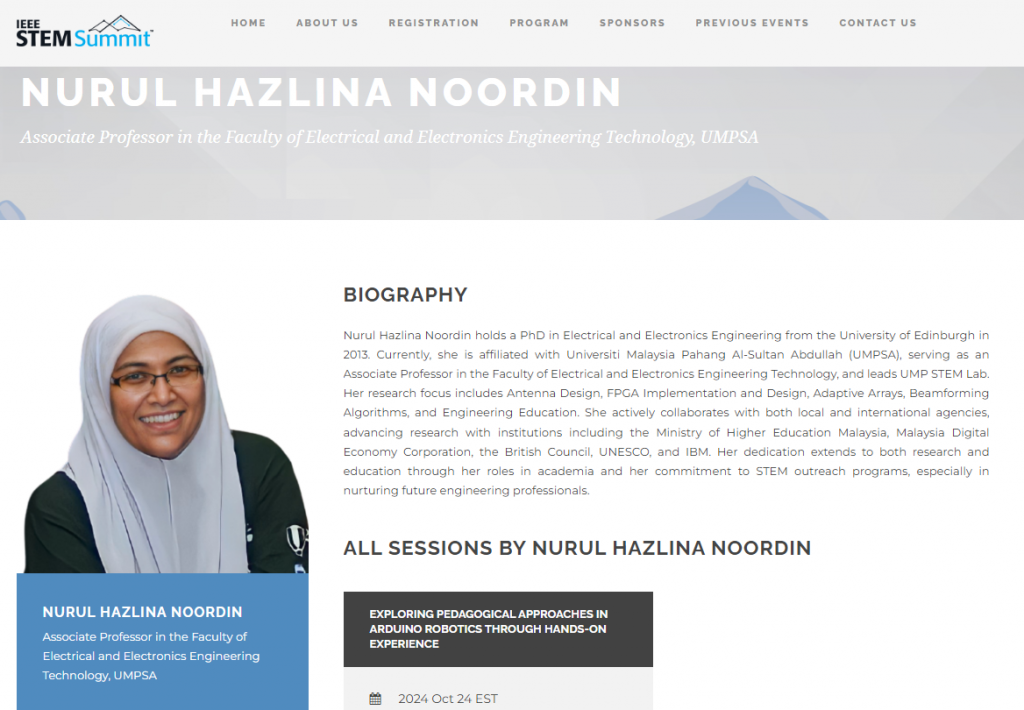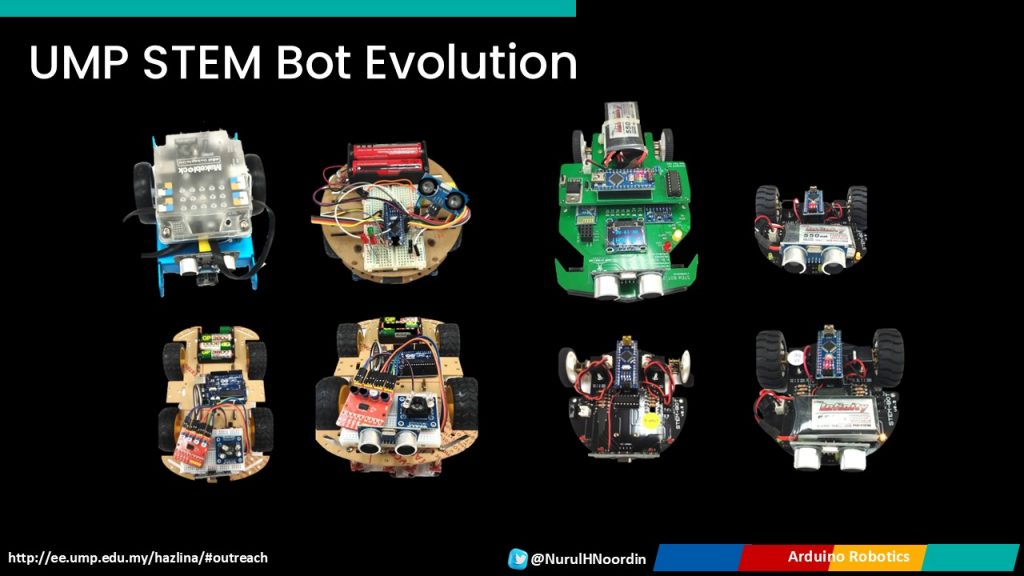STEM Summit 2024 is happening now Website







Exploring Pedagogical Approaches in Arduino Robotics Through Hands-On Experience at the 2024 IEEE STEM Summit
The 2024 IEEE STEM Summit brought together educators, researchers, and industry professionals to explore the latest trends and challenges in STEM education. At this event, I had the honour of presenting on “Exploring Pedagogical Approaches in Arduino Robotics Through Hands-On Experience,” where we discussed methods of engaging students in robotics, focusing on building skills through direct, hands-on activities.

The presentation aimed to illustrate the value of blending practical robotics work with foundational theory, especially when working with Arduino robotics, to enhance student learning outcomes.
Key Themes and Teaching Approaches
The main theme of this presentation was how a well-designed hands-on approach can havean impact on learning and make complex topics like robotics and electronics more accessible. Teaching Arduino robotics requires balancing both theory and practice. For students to truly understand the inner workings of a robotic system, theoretical concepts should be taught alongside practical applications, where students directly apply what they’ve learned.

In developing a well-rounded robotics curriculum, the following approaches are emphasized:-
- Incremental Learning through Project Complexity
Arduino projects were designed to start with simple tasks, such as lighting an LED, and gradually advanced to more complex projects involving sensors, motors, and data communication.
- This approach, where complexity is added progressively, allows students to build confidence and competence before tackling more challenging concepts like integration and control.
- Black Box to White Box Approach
- For beginners, the “black box” method is ideal—they can quickly see results without needing to understand the system’s inner workings. As they progress, students are introduced to the “white box” approach, where they delve deeper into component connections, circuit design, and eventually, creating their own PCBs.

- This shift from black box to white box allows students to explore robotics at different levels of complexity based on their skills and confidence.
- Balancing Theory with Practical Application
- A hands-on robotics curriculum is most effective when balanced with supporting theory. For example, students might first learn about voltage dividers or basic control theory before applying it to Arduino circuit design. Theory complements hands-on tasks by allowing students to validate their project findings and understand the principles driving their robot’s behaviour.

- This balance provides a “learn-by-doing” model where the value of theoretical knowledge becomes evident in practical applications.
- Scaffolding to Address Cognitive Overload
- Robotics can be complex, especially for novices. By scaffolding tasks, we can break down complex projects into manageable activities.

- For example, students start by building and testing simple circuits on a breadboard before soldering them onto a PCB. This helps prevent cognitive overload and gives students confidence as they master each stage.
Towards the end of the presentation, participants posed questions, reflecting on the pedagogical aspects in enhancing the Arduino robotics curriculum.
Here’s a recap of some key questions and my responses –
- How “deep” is the white box approach? Do students actually solder discrete components?
- Yes, the white box approach goes deep, guiding students to construct their robot from scratch. They progress from breadboarding to soldering and, eventually, designing their own PCB—after thorough testing on the breadboard to validate their circuit design. Check-out our module on circuits design and simulation on TinkerCAD and Wokwi.
- When entering circuit design, do you cover foundational theories like voltage dividers and bridge circuits?
- Absolutely. We walk students through these essential circuit theories, such as voltage dividers, bridge circuits, and stepping up/down voltages, to ensure they understand the principles they’ll apply in the hands-on tasks. Sensors integration and their building circuits among other activities covered.
- How do you recommend balancing hands-on work with theoretical learning in robotics?
- There’s really no one-size-fits-all answer to balancing theory and hands-on work. Well, theory is essential to support hands-on activities—it serves as a foundation that validates the findings or outcomes of practical tasks. So rather than separating the two, theory should flow naturally alongside hands-on work, helping to clarify and reinforce what students observe in real time.
- For me, balance means students can connect their hands-on experiences with theoretical understanding—being able to reason out their findings during activities. When they can explain why something works (or doesn’t) based on underlying concepts, that’s when the learning truly resonates.
- Are you familiar with any work that takes this approach further to circuit design and behavior? For example introduce test tools like oscilloscopes and logic analyzers to introduce students to communications channel behavior
- Yes, what we’ve done is, once students are familiar with the robot’s anatomy (like the 2-wheel robot), we move to circuit design. They experiment with integrating IR sensors and motor control, building from off-the-shelf components. They solder the circuits, measure performance, and eventually create their own PCBs. This hands-on approach gives them a deeper understanding of circuit behavior and design.
- Have you found this approach more effective for particular age groups or skill levels?
- Age is secondary =). Rather than age, it’s more about the student’s skill level. Beginners benefit from a black box approach, while those with a stronger foundation excel with the white box approach. Tailoring the curriculum to a student’s competence level helps build confidence and ensures successful outcomes. Novices engage best with a black box approach to build confidence, then progress to white box as their skills and understanding grow.
- What Arduino project is best for students as they advance?
- For a beginner aiming to pursue advanced robotics, I’d encourage them to explore whichever path interests them most, as passion often drives deeper learning and persistence. Start with projects that build foundational skills—like simple sensor integration or basic movement programming—and gradually take on more complex tasks, such as multi-sensor fusion or autonomous navigation. Consistently challenging yourself just one level up, and taking time to experiment and troubleshoot, will build both confidence and competence over time.
- The best projects challenge students just a level above their current ability. For example, if they’ve mastered programming a robot with one sensor, we introduce additional sensors or more complex sensor integration. Also, integrating AI / Image processing / data analytics to its function is interesting as well.
- How can we balance hands-on work with theoretical learning in robotics
- Finding this balance can be challenging, as it depends on the student’s ability to connect theory with hands-on experience. I personally believe theory should validate hands-on findings, with concepts tested through activities, allowing students to reason through their results.
- Are you familiar with approaches that introduce circuit testing tools, like oscilloscopes or logic analyzers, to help students understand communication channels?
- Yes, we do incorporate this in advanced stages. Once students are comfortable with the robot’s basic structure, they move to tasks like integrating sensors with motor control and testing these connections. They build and solder components, measure with test tools, and eventually work up to designing custom PCBs.
- Can we use co-design pedagogical techniques’ instead of the pedagogical techniques used in this study?
- Of-course :). Co-design in education involves teachers and students collaboratively designing the learning process. Instead of students being passive recipients, they actively contribute to shaping the curriculum, setting goals, and choosing projects that are meaningful to them. By involving students in the creation of the learning experience, co-design fosters a more personalized and relevant educational process, making it especially effective for project-based learning environments like Arduino or robotics.
The presentation highlighted how hands-on learning in Arduino robotics can be transformative for students, whether they are beginners or more advanced learners. Through a scaffolded approach that combines theory and practice, students develop not only technical skills but also critical thinking and problem-solving abilities. The summit was an excellent platform to share these insights and learn from other educators in the field who are equally passionate about making STEM accessible and engaging.
Again, thank you IEEE TryEngineering for the opportunity to present at the 2024 STEM Summit! It was an honor to share insights on hands-on learning in Arduino robotics and to explore the impact of the right pedagogical approach in helping students connect with engineering concepts meaningfully =). I look forward to continued collaboration and applying these techniques to create even more engaging learning experiences. Kudos to all the speakers for their inspiring talks and fantastic!









